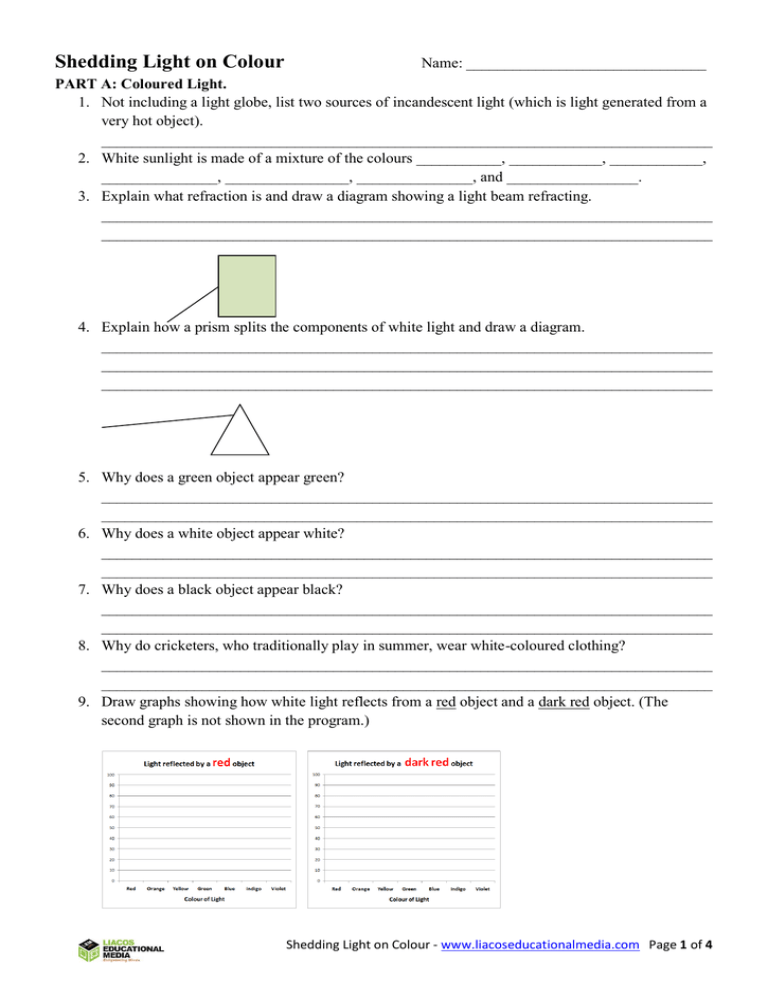Shedding Light on Colour
advertisement

Shedding Light on Colour Name: _______________________________ PART A: Coloured Light. 1. Not including a light globe, list two sources of incandescent light (which is light generated from a very hot object). _______________________________________________________________________________ 2. White sunlight is made of a mixture of the colours ___________, ____________, ____________, _______________, ________________, _______________, and _________________. 3. Explain what refraction is and draw a diagram showing a light beam refracting. _______________________________________________________________________________ _______________________________________________________________________________ 4. Explain how a prism splits the components of white light and draw a diagram. _______________________________________________________________________________ _______________________________________________________________________________ _______________________________________________________________________________ 5. Why does a green object appear green? _______________________________________________________________________________ _______________________________________________________________________________ 6. Why does a white object appear white? _______________________________________________________________________________ _______________________________________________________________________________ 7. Why does a black object appear black? _______________________________________________________________________________ _______________________________________________________________________________ 8. Why do cricketers, who traditionally play in summer, wear white-coloured clothing? _______________________________________________________________________________ _______________________________________________________________________________ 9. Draw graphs showing how white light reflects from a red object and a dark red object. (The second graph is not shown in the program.) Shedding Light on Colour - www.liacoseducationalmedia.com Page 1 of 4 10. Draw graphs showing how white light reflects from a white object and from a very very light green object. (The second graph is not shown in the program) 11. Draw a graph showing how white light reflects from a grey object. (The answer is not in the program.) 12. Describe what a green filter does. ______________________________________________________________________________ ______________________________________________________________________________ 13. Why does a green piece of paper appear black when red light is shining onto it. _______________________________________________________________________________ _______________________________________________________________________________ _______________________________________________________________________________ 14. The small grey rectangles inside the squares are the same colour. Why do they appear different? _______________________________________________________________________________ _______________________________________________________________________________ PART B: Mixing Coloured Light 15. The three primary colours of light are __________, _____________, and _________________. 16. Red light + Green light (of equal strength) = _________________light. 17. Red light + less intense Green light = ________________light. 18. Blue light and Green light = _________________light. 19. Red light and Blue light = _________________light. 20. Red light + Green light + Blue light = _________________light. 21. Describe what a colour LCD screen looks like up close. _______________________________________________________________________________ _______________________________________________________________________________ Shedding Light on Colour - www.liacoseducationalmedia.com Page 2 of 4 22. How does an LCD TV screen produce white? _______________________________________________________________________________ _______________________________________________________________________________ 23. How does an LCD TV screen produce yellow? _______________________________________________________________________________ _______________________________________________________________________________ 24. How does a computer’s colour control window work? _______________________________________________________________________________ _______________________________________________________________________________ _______________________________________________________________________________ PART C: Mixing Paints and Inks 25. The three traditional primary colours of paint are _________, __________, and ____________. 26. Explain why mixing red and yellow paint produce orange paint. _______________________________________________________________________________ _______________________________________________________________________________ 27. What are the four “process” colours? _______________________________________________________________________________ 28. Why are the process colours used in printing instead of red, yellow and blue? _______________________________________________________________________________ _______________________________________________________________________________ _______________________________________________________________________________ 29. The primary colours of light that cyan ink reflects are __________ and __________ . 30. The primary colours of light that yellow ink reflects are ____________ and ___________ . 31. When mixed Cyan and Yellow ink reflect only ______________ light. PART D: Coloured Light and Vision 32. Moving magnetism produces ______________________. 33. Moving electricity produces _____________________. 34. A fast-moving electron can produce an e_____________-f_________ wave, which then produces a m______________-f_________ wave, which then produces an e______________-f_________ wave and so on. 35. How fast do these “electromagnetic” waves travel? ________________________ 36. Light is an electromagnetic wave. What range The Visible Light Spectrum of wavelengths are perceived as red light? Colour Approximate Wavelength __________________________________________ range in nanometres (nm) 37. A laser is marked with the expression 405nm (1 nanometre = 1 billionth of a on its case. metre) (a) What does this mean? red 750 – 610 __________________________________________ orange 610 - 590 __________________________________________ yellow 590 - 570 __________________________________________ green 570 - 500 blue and 500 - 450 (b) What colour will the laser light be? indigo __________________________________________ violet 450 - 400 38. State what wavelengths of light are perceived by humans to be green? __________________________________ Shedding Light on Colour - www.liacoseducationalmedia.com Page 3 of 4 39. What are cone cells and why do we have three types? _______________________________________________________________________________ _______________________________________________________________________________ _______________________________________________________________________________ 40. What are rod cells? What is their disadvantage and what is their advantage over cone cells? _______________________________________________________________________________ _______________________________________________________________________________ _______________________________________________________________________________ 41. A person with red-green colour blindness is looking at a rainbow. How do they perceive it? _______________________________________________________________________________ _______________________________________________________________________________ _______________________________________________________________________________ _______________________________________________________________________________ 42. Birds, humans, primates (gorillas, orang-utans, monkeys etc), marsupials, and reptiles are trichromats. Most mammals, including rabbits, cats, dogs, sheep, and cows are dichromats. What is a trichromat and what is a dichromat? _______________________________________________________________________________ _______________________________________________________________________________ _______________________________________________________________________________ 43. Why is it relatively easy to diagnose colour blindness in humans, but very hard to determine how animals perceive the world? _______________________________________________________________________________ _______________________________________________________________________________ _______________________________________________________________________________ 44. Is everything coloured? Is anything colourless? _______________________________________________________________________________ _______________________________________________________________________________ _______________________________________________________________________________ _______________________________________________________________________________ _______________________________________________________________________________ Shedding Light on Colour - www.liacoseducationalmedia.com Page 4 of 4






